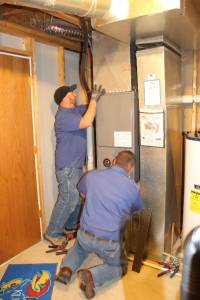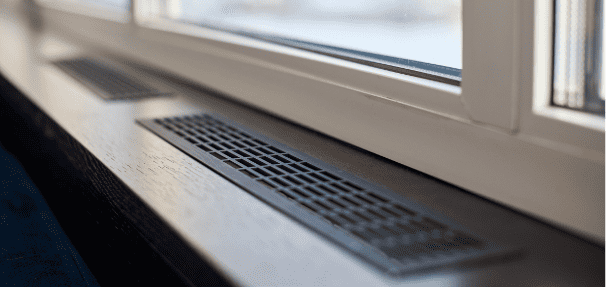Understanding a High-Efficiency Furnace Main Burner
Components of a High Efficiency Furnace

A high-efficiency furnace is one that has an AFUE rating of 90 or higher. That means that these units can convert 90% or more of the energy it uses into heat.
Hanna Heating & Air Conditioning has installed furnaces and other heating systems in Wichita and surrounding towns for over 40 years. We are your local team of home heating experts who know their way around these great new furnaces.
These modern units are well equipped to keep homes warm while saving on energy costs. One critical component of these advanced heating systems is the furnace burner. We’ll dive into what furnace burners are and how they play a vital role in high-efficiency furnaces.
What Are Furnace Burners?
Furnace burners are integral to the combustion process within your heating system. They are responsible for igniting and burning the fuel (typically natural gas or propane) to generate heat. Burners are found in the combustion chamber of your furnace, where air and fuel mix, ignite, and produce the heat needed to warm your home.
You will have either a single or dual burner. Which one you have will depend on how big your furnace is.
There are several types of burners. Newer, high-efficiency furnaces typically have an Inshot Burner. With this type of burner, a blower distributes air through the ignition chamber and heat exchanger.
How Furnace Burners Work
STEP 1: Your system detects the need for heat. The heating cycle of your furnace begins when a room goes below the temperature setting at your thermostat.
STEP 2: Then the combustion process begins with the introduction of fuel and air. A fuel valve opens, releasing fuel for the furnace burner. Meanwhile, the air intake system allows for fresh air to come in from the outside.
STEP 3: Next your furnace calls for heat. Your heater’s ignition system ignites the fuel-air mixture, creating a controlled flame. This may be a pilot light if you have an older furnace. However nearly all modern furnaces use electronic ignition.
NOTE: A flame sensor detects the presence of the flame. If the flame fails to ignite or goes out unexpectedly, the sensor signals the furnace control board to shut off the gas supply, ensuring safety.
STEP 4: Once the burner is lit, your system operates continuously to maintain the desired temperature in your home. The warm air is blown throughout your home’s ductwork and then out your vents.
Problems that Can Happen to a Furnace Burners
An older burner may be more prone to cracking. After all, it is regularly exposed to high temperatures. Over the years, that can lead to cracks.
Another problem that can happen to a burner on an older furnace age is rust and deterioration. This problem can be prevented by having professional maintenance done regularly on your home heating system.
A professional furnace technician should make sure your system is clean and can identify signs of wear. They can often replace parts that appear damaged or rusted. Keeping a furnace maintained well can often extend the life of your entire heating system.
Furnace Burner Shuts Off: Maintenance and Care
Maintenance keeps your furnace burners operating at peak efficiency. This includes cleaning the burners, inspecting the flame sensor, and ensuring proper air and fuel mixture. A well-maintained burner not only ensures efficient heating but also contributes to the safety and longevity of your heating system.
Contact Hanna Heating & Air Conditioning for professional heating maintenance service. You can call us anytime to schedule this service – either by sending us a message online or by calling 316-945-3481.
We recommend that you get furnace maintenance performed in early fall, well before you need to turn your heat on for the season.
If your furnace burner shuts off and you need immediate repair to get the heat back on in your home, call Hanna Heating & Air. We provide 24/7 emergency repair services and provide service to all surrounding Wichita communities including Newton and Andover. Call us at the location closest to you!






Add Comment